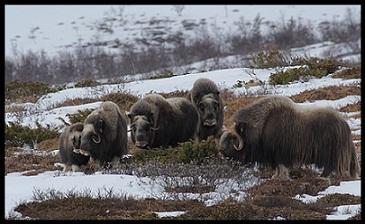Activity patterns of musk ox (Ovibos moschatus) housed in different conditions.
Final thesis, Applied Ethology and Animal Biology 2011

About 100.000 years ago the musk ox (Ovibos moschatus) lived in Scandinavia with mammoths, saber-toothed tigers and woolly rhinoceroses. The populations of musk ox were large and had high genetic variation. Today in Sweden the musk ox population is nearly extinct and one reason for that is low genetic variation between the animals. The explanation is that they are descends from only 10 individuals originated from Greenland. To use the metapopulation managements, the genetic variation could increase in the wild population. This requires collaboration between the wild population and the captive musk ox in different facilitations. A direct reintroduction of captive musk ox to the wild population can cause problems. By improving the body condition the animals’ possibility to survive in a wild habitat can increase.
The aim of the study was to investigate the musk ox activity in relation to the size and shape of the enclosure, as well as if changing of feeding and watering places can increase the activity of the musk ox, and thereby improve their hoof status. These measures could lead to a better reintroduction of musk ox into an established wild population in the future.
Responsible for this page:
Director of undergraduate studies Biology
Last updated:
05/16/11
